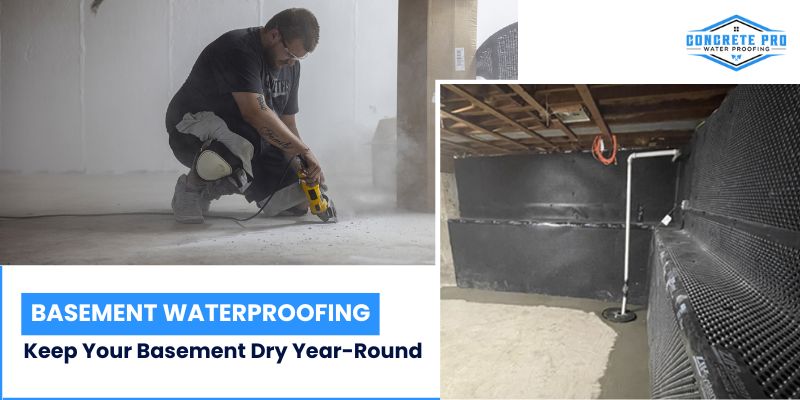
Your home faces moisture issues throughout the year, from springtime rains to winter snowmelt. You can safeguard your basement from water damage through the use of drainage systems, while applying sealing services and regular maintenance inspections. Following effective basement waterproofing methods is the primary defense against mold growth and water based damage for homes.
Common Causes of Basement Water Problems
Detecting the source of moisture is essential, so that you can prevent issues. Issues with water in your basement are typically caused by the following:
- Poor Drainage Around the Foundation: Water accumulating near a house foundation will eventually penetrate the basement. House protection requires adequate drainage systems, consisting of gutters and downspouts, to move water safely away from the building.
- Cracks in Foundation Walls or Floors: Any small foundation cracks can make your basement vulnerable to water intrusion. Foundation cracks caused by settling or pressure will expand into bigger openings, if homeowners do not fix them promptly.
- Improper Sealing of Brick or Concrete: Your foundation will allow water penetration, when its brick and concrete surfaces remain unsealed. Heavy rain brings the risk of basement flooding, along with basement dampness, when your foundation is not sealed properly.
- High Water Tables or Heavy Rain: Groundwater pressure builds up as the water table increases during high rainfall. The increased water pressure from outside foundation walls can force water through structural cracks and pores in the building.
- Aging Construction Materials: The materials used in your foundation degrade with time. Basement water infiltration becomes more likely as concrete, mortar and other materials naturally age, making older homes more susceptible to water damage.
Signs Your Basement Needs Waterproofing
You need to determine if your basement shows signs of trouble. Look out for these signs:
- A strong, musty odor emerges, indicating that your basement has trapped moisture.
- Water damage becomes visible through brown or dark marks on walls or floors.
- Mold growth in your basement indicates the presence of moisture, since mold only appears in damp conditions.
- Foundation or basement walls develop cracks that extend beyond minor cosmetic concerns. Water can penetrate your home through damaged structures that result from these issues.
- The presence of efflorescence (a white, chalky residue) indicates water leakage through your foundation.
Year-Round Basement Waterproofing Solutions
For year-round basement waterproofing, you need expert solutions. Depending on the signs, any combination of these solutions is effective.
1. Basement Waterproofing - A professional basement waterproofing solution is essential for keeping water from entering your basement. Sealants must be applied, sump pumps must be installed, and the system needs to improve ventilation.
The installation process blocks water from getting into the basement, maintaining its dry condition. Your home requires a dry basement, because it protects your living area and the overall building structure during all seasons.
2. Brick Sealing - Sealing your foundation’s brickwork is crucial, because it prevents basement water damage. Ensure that you employ professional brick sealers who apply quality sealants that stop water from entering the porous brick surface, keeping your basement dry and comfortable.
Brick sealing is a cost-efficient method that successfully protects buildings against leaks. Contact an expert quickly, when you notice any sign of porous brick.
3. Foundation Drainage - Your home requires an appropriate foundation drainage system, which diverts water away from the property. The installation of drains, combined with leveling your landscape, will stop water from creating pools next to your foundation.
A controlled water flow system minimizes basement flooding and moisture problems. Proper implementation of this technique ensures a dry foundation that remains secure.
4. Water and Moisture Control - Basement humidity control depends heavily on the combination of dehumidifiers, vapor barriers and moisture control systems. These tools stop mold development, while protecting your foundation from water damage.
The air stays dry when you control moisture properly, reducing health problems related to high humidity levels. Your home’s structure remains intact through its application.
5. Crawl Space Encapsulation - The crawl space encapsulation process involves installing a vapor barrier to seal the crawl space, while adding insulation. The proper obstacles are installed, to stop moisture from entering your basement space.
Encapsulation allows you to achieve better energy efficiency, by controlling indoor temperature. The process creates a dry basement that reduces utility expenses, while delivering a steady environment during humid and wet weather.
6. Foundation Stabilization and Repair - Foundations gradually shift and settle, resulting in cracks through which water penetrates. Foundation stabilization and repair services reinforce the foundation structure, solving these issues.
The necessary repairs create a watertight barrier that stops water from entering damaged regions, thus maintaining a dry basement. Urgent stabilization interventions will prevent both current and future costly home repairs, while defending structural components.
7. Concrete Leveling - Water accumulates in specific areas, because foundation slabs and concrete floors develop uneven surfaces. Concrete leveling services lift depressed sections of uneven surfaces, to achieve level floors.
The procedure ensures that water cannot accumulate in lower areas, protecting against water related damage. Concrete leveling improves the stability of the floor, creating essential conditions for basement dryness and preventing structural damage from occurring.
Conclusion
Basement waterproofing protects your home, by preventing water damage and surplus moisture issues. Solutions such as waterproofing, brick sealing and foundation repairs make year-round basement dryness possible. These work to resolve common problems, including poor drainage, cracks and bad sealing methods. The strategies implemented protect your home’s structure, while preserving its foundation.
Contact Concrete PRO to arrange a professional inspection, to keep your basement completely dry throughout the year.

